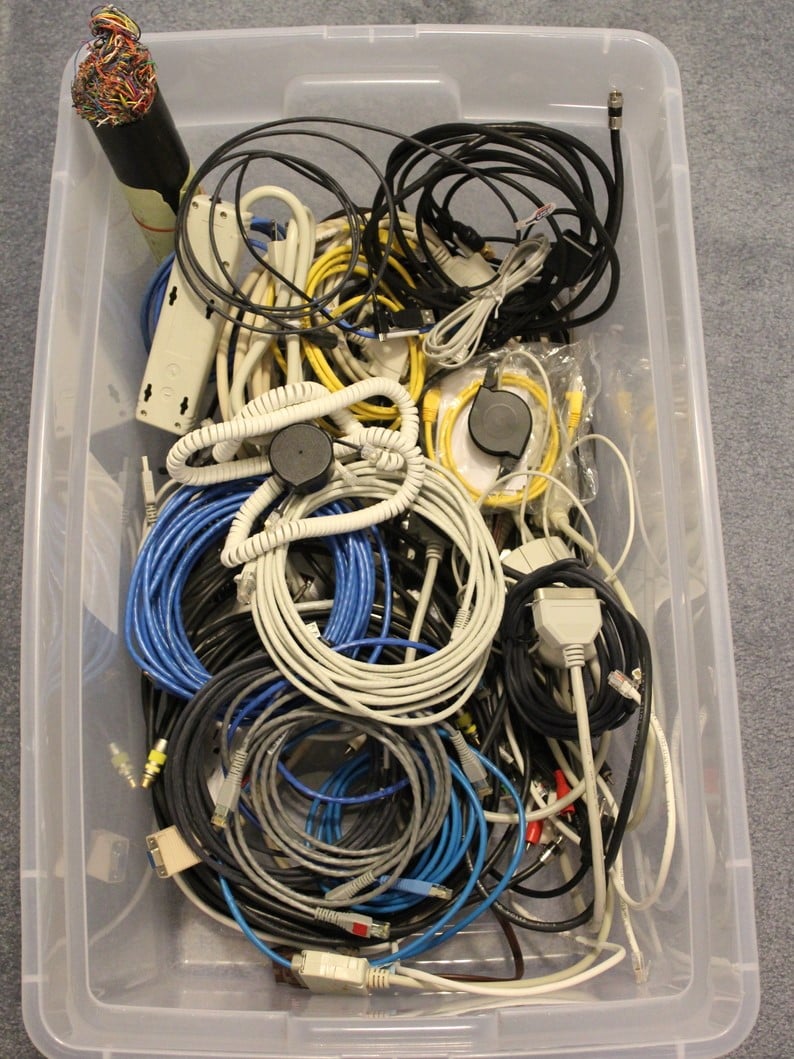
Welcome back to Tech Service Today's IT Disaster of the Week series where we display pictures of the ugliest IT environment our technicians run into each week. Actually, this week's photo is of something you can find in almost every IT professional's office or data center: The Cable Bin.
Sometimes patch cables are stored in a huge cardboard box; other times they are in a barrel, a garbage can, or a plastic storage bin like the one shown here. I have even see a coat rack used to hang patch cables (which, I must admit, was a very creative and effective way to store and access cables).
Regardless of the form of container used, IT professionals almost always have a bunch of extra data cables and power cords stock-piled somewhere in their office. And those cables tell me a lot about the IT professional storing them. For example, using this week's picture as an example, I know this IT professional is probably as tenured as I am in the industry because I not only see Cat5e & Cat6 patch cables and USB cables - the most common items found - but also Coax, RCA Audio, Serial, and even old Parallel cables.
I almost asked him why he had a small section of 100-pair copper cable in his bin, but decided against it when he admitted that he only recently threw out the SCSI cables that he'd held onto for years....just in case.
Everyone who stores cables in this fashion experiences the same headaches. It is difficult to find the cable type or length you need among these jumbles. And it is almost impossible to extract the one cable you want without it getting tangled on other cables. This often leads to tabs breaking off the ends of your Cat5/6 data cables, making them worthless.
While no manufacturer (to my knowledge) has developed a product that offers a simple, neat, organized way to store patch cables, there is one simple method you can employ to reduce the frustration you experience every time you dig through your cable box: it's called color-coding.
While color-coding cannot prevent tabs from snagging or breaking off your patch cables, it can eliminate the time you spend trying to find the right cable. Start by assigning one color to each length of patch cable that you use, and write those color/length assignments down so you don't forget them. For example, identify 1-ft cables to always be black; 3-ft cables Blue; 5-ft cables Red; 7-ft cables Yellow, 10-ft cables Green, etc. You may even want to post your color-coded length chart on the wall above your cable box/bin.
Next, purchase only patch cables in the Length-Color pairings you defined. And then throw them in your cable bin/box. With your new color-coding scheme in place, the next time you go to your cable box in search of 7-foot cable, you can visually identify a yellow cable immediately and be on your way.
At TST, we have an intimate understanding of the frustrations that IT professionals experience every day. Our goal for offering tips in this IT Disaster Of The Week series is to help you reduce or eliminate some of those headaches. But if your cable bin is like this week's photo (meaning it contains items like parallel cables because your company still has equipment that uses them), then your headaches won't go away until you convince your boss to let you upgrade your IT equipment and network - a project that TST can help you complete successfully and on-time.
Check back every Friday for TST's latest IT Disaster of the Week photo
which represents one of the thousands of customer sites our technicians visit every year as they install and service IT, networking, and telecom equipment & cabling for our clients.
Click here to see last week's IT Disaster photo.
Do you already have an IT disaster that needs to be cleaned up?
It doesn't take a rocket scientist to install a network. But to ensure that your equipment, racks and cabling are installed properly in an organized, efficient fashion, it does require the talents of a skilled IT technician. If you need help installing or cleaning up your network, contact Tech Service Today to have a skilled, seasoned Technician dispatched to your site.
Need help installing, troubleshooting, testing, documenting, or replacing your network cabling? Call Tech Service Today for on-site technical services anywhere in North America - often in 4-hours or less.
Just call (800) 973-2022 (option 1), or Email us at Service@TechServiceToday.com

